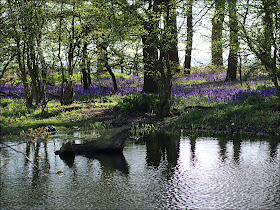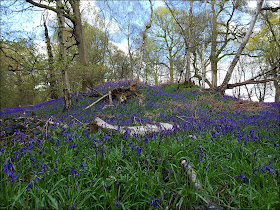Maybe, just maybe, I thought, if I my steps lead me through some patches of woodland, then perhaps I might find a bluebell or two.
Well, yes, I did. I wondered, I wandered and I was filled with wonder. It's said to be only the fairy-folk who can hear the tinkle of these tiny bells which call them to their conventions in the ancient woods; but every year many of us big, clumsy people also blunder into the woods to enjoy the bluebells.
And they are ancient woods too; any wood containing a goodly quantity of the flowers is reckoned to date from at least 1600.
Bluebells occur throughout Western Europe but most of the really good shows of the flower are in Britain (though I might be a bit biased in my opinion!). Our bluebell woods, though, are under threat from the advances of the modern world - time for the fairy-folk to sit up and take notice then. They are protected by law and you mustn't pick them and certainly you mustn't dig them up.

In fact they are protected by lore as well as law, since it was long believed that bad luck would befall those who picked the little blooms. Modern science has shown that trampling the ground, even before the plants have appeared above ground is even more harmful than picking them. So if you venture out to see the bluebells it is important that you really do follow the rules and stick to the footpaths.

Now those of you who follow my ramblings closely might be thinking that I have a pet pheasant to accompany me on my walks. But this is a different one from the one I photographed recently in Cambridge. Or at least I think it is.
Other flowers are available to be photographed too. The selection above, cowslip, wood anemone and primrose, were all found in a meadow, though from the wide variety of woodland flowers that were present it may well have been wooded in the fairly recent past.
There were bluebells in this coniferous plantation too, which almost certainly indicates that there was an old broad-leafed woodland here before the conifers were planted.
There are a handful of other names for the bluebell though the name is so obviously desciptive that it seems almost perverse to call them anything else. Somewhere I've read that they were sometimes called Dead Man's Bells, which related to the story that the fairies would strike a man dead if he dug up the bulbs. There may be some truth in that, for the bulbs contain several toxins. Most of our ancestors were too practical to worry their heads about such superstitions and dug them up regardless, for an excellent glue could be made from the bulbs, just the job apparently for sticking feathers on to arrows.
I may well have been following a forgotten road through part of Newton Wood; the bank above had another running parallel to it about the right distance away.
I've been so busy looking at these little flowers that I almost forgot that I'd seen something marked on my map that I'd intended to investigate.....
And there it is - covered in bluebells, naturally enough - a prehistoric burial mound, dating back maybe 3,000 years and probably to a time before this land was wooded. Or perhaps that's just a fairy story......
Take care.






















































